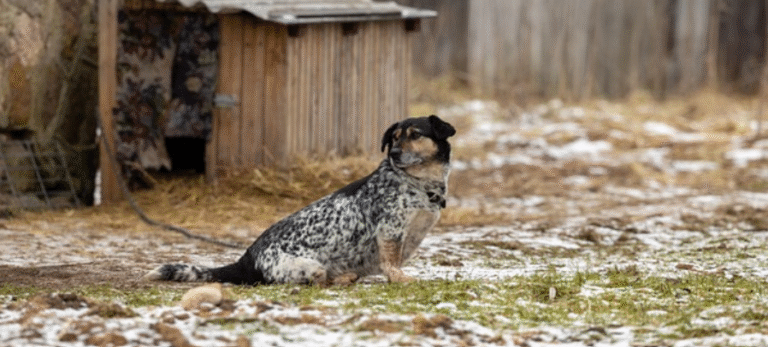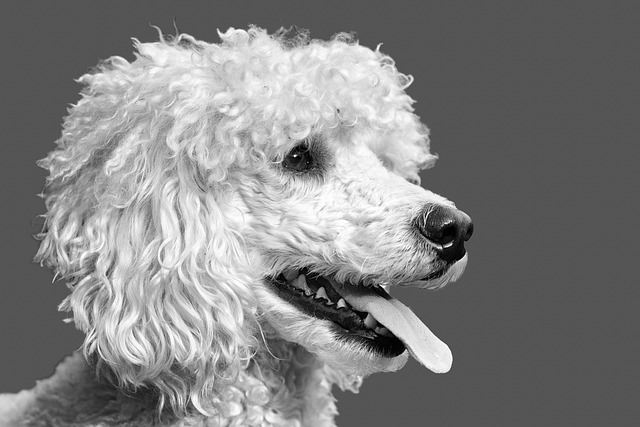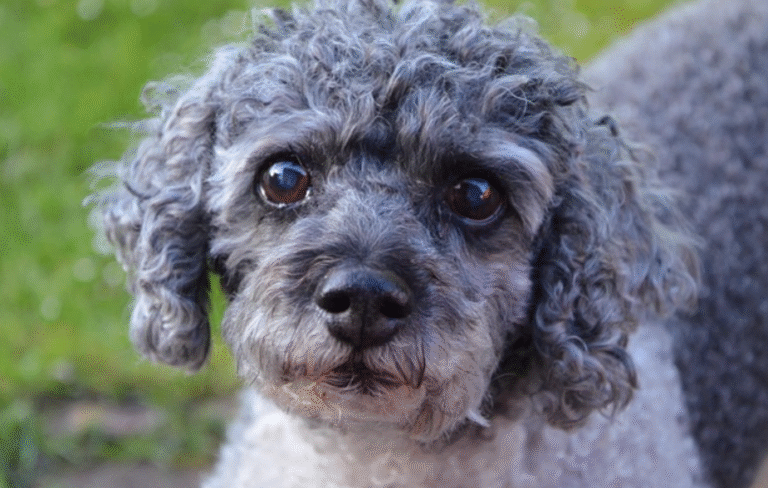A pyredoodle puppy—pyredoodle is a term for this hybrid dog that results from breeding a Great Pyrenees with a Standard Poodle. In the United States, these puppies are known for their long, silky, often wavy coat and gentle, even-tempered dispositions.
This is why so many families gravitate towards a pyredoodle puppy—less shedding than a purebred Great Pyrenees. These puppies are known to typically get along with children and other animals!
This means that most pyredoodles will end up being very large dogs, with weights for adults usually between 85-100+ pounds. Their combination of watchdog instincts and loving goofiness makes them ideal companions for energetic households.
They flourish in environments that allow them to move around! The following sections provide an overview of how to raise, train, and care for a pyredoodle puppy.
What Is A Pyredoodle Puppy?
The Pyredoodle is a hybrid breed between the Great Pyrenees and the Standard Poodle. Originating in the United States, this hybrid first appeared in the 1980s. Other breeders were focused on creating a low-shedding, allergy-friendly dog with a gentle disposition.
The breed took off in popularity during the early 2000s as families sought out pets that were intelligent and gentle. While the Pyredoodle is currently not recognized by the American Kennel Club, this hybrid is commonly referred to as a designer breed. Other names for this mix are Pyreneespoo, Pyrepoo, and Pyreneesdoodle.
1. Parent Breeds: A Gentle Mix
The Great Pyrenees is a big, gentle breed, revered for his peaceful demeanor and fierce guardianship. On the other hand, the Standard Poodle is well-known for his intelligence and hypoallergenic fur.
When mixed, the Pyredoodle often gets the best of both: a loyal friend that loves to guard yet learns new things fast. This mix may have a wavy or curly, hypoallergenic coat.
2. Pyredoodle Temperament Unveiled
Pyredoodles tend to be sweet, gentle, and protective beings with rich personalities. They become fast friends with children and adults.
While they are typically calm at home, they may appear timid in the presence of strangers. When you expose them to a variety of experiences as puppies, they’ll mature into self-assured, calm-natured friends.
3. Standard vs. Mini Pyredoodles
Standard Pyredoodles may grow to 32 inches and 100 pounds, but minis do not get that large. Larger breeds do best in homes with yards where they have room to romp, but miniatures are perfect for apartment living.
Their needs for exercise is another consideration. The two require daily walks and playtime.
| Type | Height | Weight | Best for |
|---|---|---|---|
| Standard | 25-32 inches | 85-100 lbs | Yards, active homes |
| Mini | 15-22 inches | 40-65 lbs | Apartments, less space |
4. Unique Looks and Traits
Coat colors range from grey to white, apricot, cream and black. Their coats tend to be hypoallergenic, but can be straight or wavy.
Their lifespan is the same 10 to 12 years.
5. Why This Doodle Shines
Pyredoodles are sweet, calm, gentle, loyal, and protective, making them great companions for children. They adapt easily to varied living environments and are suitable service dogs.
Their unique combination of smarts and sweetness is what makes them special.
Is This Breed Your Match?
Like any mixed breed, selecting a pyredoodle puppy involves considering your daily routine, family environment, and desired outcomes. This blend of the Great Pyrenees and Poodle delivers an intelligent, large breed with moderate energy.
Whether you’re considering adopting one or you just want to learn more, it’s useful to take an introspective glance at your lifestyle and needs.
Your Lifestyle and Pyredoodles
Engaging companions, Pyredoodles make wonderful companions for active people. They require a minimum of 30 minutes of vigorous physical activity daily, such as long walks or play sessions in the yard.
Their streak of independence makes them a good match for busy households, but they thrive when there’s someone home most of the time. Their emotional, mental and social needs are just as strong, so providing daily quality time together is essential.
Consider these lifestyle factors:
- Time for daily walks and play
- Flexible work schedule or pet-friendly job
- Willingness to commit to training routines
- Room for indoor and outdoor activities
Family Life: Kids and Pets
Pyredoodles usually do great with kids and other animals. Their gentle side makes them great with kids, while their protective instincts provide an extra layer of peace of mind.
With pets, plenty of slow and deliberate introductions allows everyone to feel more comfortable. As with all dog play, especially with small children, always supervise closely.
Energy Levels: Active Companions
These pups have a ton of energy, so they enjoy rough housing, chasing, playing, and discovering new things. Like many of the large breeds, they require consistent, moderate activity—not over exertion.
Regular jogs, a good game of fetch, and some mental exercise with puzzle toys will help them stay sharp. Try these activities:
- Hide-and-seek games
- Tug-of-war
- Long leash hikes
- Food puzzle feeders
Living Space Considerations
Pyredoodles do just fine in an apartment or a house as long as they get a lot of exercise. Fenced yards are ideal, but enclosed urban parks are suitable as well.
Provide them with a safe, warm area to sleep that’s free from cold drafts and heavy commotion.
Finding Your Furry Friend

Once you start the process of bringing a pyredoodle puppy into your life, it’s well worth the time and effort to find your perfect match. This process requires thoughtful consideration of your lifestyle, your home, and the time you can dedicate to a new pet. Understanding reputable pyredoodle breeders and rescues enables you to make a great decision on your new furry friend, ensuring a wonderful addition to your family.
Choosing Ethical Breeders
An ethical breeder will go above and beyond for their dogs’ health and welfare. They maintain sanitary conditions, provide all animals with proper care and socialization, and only breed dogs that are healthy. With pyredoodles, health tests on both Great Pyrenees and Poodle lines are important.
Meeting the breeder in person allows you to get a sense of the puppies’ living environment. When looking for a reputable breeder, seek these traits:
- Open about puppies’ health records
- Shows health certificates for parents
- Welcomes visits and questions
- Limits the number of litters per year
Key Breeder Questions
Inquire with breeders about the puppy’s parents, their health, and how they raise their puppies. Find out if they test for hip dysplasia or genetic disorders. Responsible breeders will explain how they socialize their puppies and say something about their experience with doodle mixes.
Being open about any previous health issues is a sign of trustworthiness.
Puppy Health: Early Signs
Look for bright eyes, clean ears, and a soft, glossy coat. Puppies should be an active, energetic bundle of joy. Early vet visits help identify issues, such as digestive distress or skin irritation, before they escalate.
Key health indicators include:
- Steady weight gain
- Clear eyes and nose
- Clean skin
- Regular appetite
Considering Pyredoodle Rescue
By adopting from a rescue, you make room for another dog in need. Most experienced rescues are familiar with the breed and can place you in the best possible fit. Understanding a dog’s history allows you to manage expectations from the start.
Most local doodle rescues will have online listings of dogs currently available for adoption.
Preparing For Your New Arrival

Preparing your home for a pyredoodle puppy is an adventure! It takes more than luck — it takes some serious planning and know-how. Having a safe, warm environment will make it easier for the puppy to relax during what may be an overwhelming first few days.
Just a few simple steps can go a long way. They’re going to be instrumental in making sure that you and your new family member are welcomed in the best way possible! Below, you’ll find advice and resources to help orient you.
Make Your Home Puppy-Safe
Rambunctious young pyredoodle puppies with an adventurous spirit often get into mischief quickly. Common household dangers, such as electrical cords and small toys, can pose choking hazards. To ensure safety, hide cords or use protective coverings and remove toxic plants and cleaning products from their reach.
Creating a calming area, such as with a crate and padded bedding, can provide your puppy with a space to relax. Baby gates are also effective for shutting off stairways or forbidden areas, allowing novice dog owners to control the movement of their puppies. This management is essential for monitoring their exploration and ensuring a safe environment.
As potential pup parents, it’s crucial to understand the breed characteristics of pyredoodle owners and how to keep your home safe. By implementing these precautions, you can create a secure space for your energetic dogs to thrive and explore safely.
Must-Have Puppy Supplies
Having some essential puppy supplies ready before your new arrival will make those first few days more comfortable for you both. Pyredoodles will require durable bowls for food and water, as well as a collar that includes an ID tag and a leash.
Selecting puppy food that is veterinary approved will ensure your pup grows healthy and strong. Chew toys, like bully sticks, will occupy their time and support them through the teething process.
Things like grooming tools or brushes come in handy as pyredoodles do shed. Essentials include:
- Crate and bedding
- Puppy food and bowls
- Collar, leash, ID tag
- Chew toys
- Grooming brush
First Days: Easing Transition
It’s all about the first week. Keeping a consistent feeding and potty schedule is key to helping your puppy adjust quickly. Allow your puppy to interact with new humans and animals individually.
Provide ample positive reinforcement and maintain a peaceful atmosphere. Be alert for signs of stress, and if you’re concerned about health at any point, call your veterinarian.
Having a designated sleep area assists with crate training and bedtime.
Raising A Happy Pyredoodle

Raising a happy pyredoodle puppy requires both patience and a plan, along with consistency and routine. These dogs flourish with a strong but loving pack order established at home, regular exercise, and plenty of playtime.
They’re adaptable to living in everything from urban apartments to large suburban lawns, as long as they receive plenty of exercise and mental stimulation. Happy pyredoodle training, nutrition, grooming, and health are all important areas to be mindful of to ensure their happiness.
Smart Training Strategies
Pyredoodles learn best with brief, energetic training sessions combining simple commands and enjoyable activities. These dogs respond better to positive reinforcement, and will enjoy your praise, treats, and gentle guidance over scolding any day.
Predictable voices and procedures foster confidence. Puppy classes are a fun way to get dogs and owners learning together! Secondly, they give puppies a controlled environment to be introduced to other dogs and people.
Training tips:
- Use the same words for each command
- Keep sessions under 15 minutes
- Reward calm, good choices
- Mix play with lessons
Puppy Nutrition Essentials
Young pyredoodles should eat a high-quality, well-balanced diet richer in protein, fats, and carbohydrates intended for big breeds. Choose kibble with meat as the first ingredient and avoid fillers.
Monitor servings to maintain weight in check, as these pups can become overweight if they’re given too much food. During colder months, a little extra caloric intake can boost their energy.
Nutritional guidelines:
- Feed large-breed puppy food
- Watch meal sizes
- Give fresh water
- Limit treats
Grooming That Fluffy Coat
Their undercoats shed and mat if not brushed at least 3 times a week. Fluffy coats require a professional groomer from time to time.
Keeping skin folds clean, bathing only when dirty, and making sure their skin is always dry and clean can prevent issues.
Grooming tools:
- Pin brush
- Slicker brush
- Nail clipper
- Dog-safe wipes
Pyredoodle Health Watch
Look out for hip dysplasia, gastritic bloat, and skin allergies—prevalent in this crossbreed. With regular vet visits and a healthy lifestyle, we can catch issues earlier.
Understanding the history of both parent breeds will assist you in preparing to care for your Pyredoodle.
First Year Growth Guide
Pyredoodles grow rapidly, reaching important growth milestones at three, six, and twelve months. The key is to weigh and measure regularly, and adjust food and exercise accordingly as they mature.
Developmental stages:
- Weaning (6–8 weeks)
- Social bonding (8–12 weeks)
- Teething (3–6 months)
- Adolescent growth (6–12 months)
My Pyredoodle Experience: POV

The experience of owning a Pyredoodle in Los Angeles is a unique roller coaster of highs and lows. With their sunny disposition, colors, and clownish antics, these dogs truly light up the home. Though they can be aloof with strangers, they are very affectionate with their immediate family and serve as both fierce defenders and devoted pals.
Raising a Pyredoodle has taught me to be intentional about how I provide for them each day while appreciating the unique personality they possess.
The Unmatched Joy They Bring
Pyredoodles do best when they have company. Park fetchers and long city walks are their favorites. To most owners, myself definitely included, I think their mischievous antics and sunny disposition make even the darkest days brighter.
Their gentle, patient, and protective temperament around children is legendary. Even the little things, like when I’m teaching them new tricks or seeing them sleep, contribute to happiness. No wonder families give them such high marks for being family-friendly.
Surprising Pyredoodle Quirks
Our experience with Delilah—what we’ve learned
Every Pyredoodle has their quirks. Many Pyredoodles will bark or howl at unusual times which can catch new owners off guard. Then there are those who’d simply look to sneak out the gate, so a solid fence is essential too.
Even with these habits, one look at their goofy grin or head tilt can turn a rotten day into a great one. Other owners report that their dogs’ tendencies don’t really alter, so be ready to wait.
A Lifelong Loving Commitment
A Pyredoodle’s life is a delightful, consistent commitment. Frequent walks, brain games, and wellness check-ups with the vet are essential for their longevity. Getting them socialized from a young age goes a long way towards helping them become proper city citizens.
Stopping excessive barking and wandering requires consistent training, but the connection fostered during training makes every second spent worthwhile.
What I Wish I Knew First
We cannot overstate the importance of doing research prior to welcoming a Pyredoodle into your home. Although many believe they’re never active, most require activity every day or they become hyper.
Having local meetups or online groups provides more valuable support and advice from other owners.
Conclusion
A gentle pyredoodle puppy makes a perfect addition to an active, joyful, loving home. They tumble in the meadows, flop out on the sofa, and demonstrate the genuine attractiveness within every single wag. Big, soft, and sweet, they add a calming energy to a bustling household.
It does take time to train a pyredoodle, they learn quickly and are eager to please their humans. People in L.A. Recognize these little dogs when they encounter them in dog parks or on leashes on sunny sidewalks. Pyredoodle is ideal for an active lifestyle who desires a companion with heart and intelligence. Looking forward to making your own pyredoodle, begin your puppy search, contact local breeders or rescues, and meet your future companion. Who knows, your new furry shadow may be waiting just around the bend.
Frequently Asked Questions
What is a Pyredoodle puppy?
What is a Pyredoodle puppy? These adorable pups are beloved for their intelligence, gentleness, and hypoallergenic qualities, making them excellent family dogs.
Are Pyredoodles good family dogs?
Yes, Pyredoodles, known for their gentle demeanor and loyalty, are excellent family dogs, making them ideal companions for novice dog owners, especially those with space for a larger dog.
How big does a Pyredoodle puppy get?
Expect adult Pyredoodles, a wonderful designer dog breed, to stand 23 to 30 inches tall and weigh 85 to 100 pounds on average. They can stand as tall as 32 inches at the shoulder, and they require space to roam and be active.
Do Pyredoodles shed a lot?
Pyredoodles tend to shed less than most other large dog breeds. Thanks to the Poodle mix, their coats are typically wavy and low-shedding, though frequent brushing remains essential.
What should I feed my Pyredoodle puppy?
Choose a high-quality, large breed puppy food for your Pyredoodle puppies. Look for a premium formula where the first ingredient is actual meat and no artificial fillers, ensuring your pup has the best nutrition.
How much exercise does a Pyredoodle need?
Pyredoodles, known for their wonderful traits, require a good amount of daily exercise, including long walks and vigorous play sessions in a secure yard, as they are energetic dogs that thrive on mental and physical stimulation.
Where can I find a Pyredoodle puppy in Los Angeles?
Find responsible pyredoodle breeders in the greater Los Angeles area, or visit area rescues and adoption events. Always go to the breeder, do your due diligence, ask questions, and meet the puppy’s great pyrenees parents if you can.






